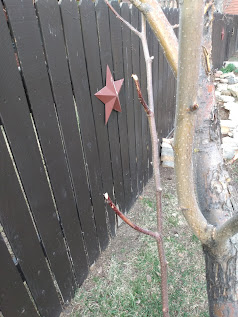Posted by: Todd Hagenbuch, CSU Extension, Routt County
 |
| Classic rabbit 'trimming' of smaller branches |
While many of you reading this blog have been watching the
daffodils and crocuses bloom for a few weeks, those of us in the higher
elevations are just seeing the ground as it becomes uncovered by rapidly
melting snow. As the snow recedes, what’s becoming evident is that, at least in
Routt County, several types of varmints had a hay-day under the snow and
treated our yards as an all-you-can-eat buffet. I’ve gotten many calls in the
past two weeks with folks wondering what creature has caused the damage they’re
seeing in their yards, pastures, and hay meadows. I also find that people often
blame the wrong critter, or have had multiple species wreaking havoc.
 |
| Vole damage at the bottom, rabbit damage above |
The first thing we’ve seen as the snow levels dropped is that rabbits dined on several things, especially fruit trees. Lots of folks talked this winter about the number of jackrabbits in the area this year, and mentioned the damage they were seeing to local haystacks. We see now that they were taking advantage of town plants, too, with branches being trimmed and trunks being scalped at varying levels according to the snow level when they came by. I’ve seen several crabapple and apple trees that look to be a total loss due to the rabbit damage they’ve sustained.
As the snow pulled away from the bases of trees, shrubs, and
herbaceous perennials, vole damage has come into full view. Have you seen
girdling around the bottom of trees, along the soil line? Vole damage. Gnawing
marks on the stems of small bushes? Vole damage. Perennial plants that had unexplained
chewing at the base? Yep, probably voles!
 |
| Vole damage on lilacs |
photos). They still had some small piles of snow near the trees which looked like Swiss cheese, with holes into and out, right in-line with the classic vole ‘runways’ that appeared around the lawn. In fact, as we sat and were looking at the bushes, the little beasties popped their heads out and ran from pile to pile! Little tufts of grass where they’ve disturbed the surface and small holes are other telltale signs that voles enjoyed the warmth and protection of a blanket of snow while feasting on our plants.
 |
| Vole damage on apple |
The other varmint that had a regular rager under the snow
was the pocket gopher. While they live under the soil and dine on roots, the
soil they dig out for their subterranean feasts was neatly packed away in
tunnels under the snow in long, curing, snake-like piles that are called
eskers. People expect to kick at the eskers and find holes or tunnels
underneath, but what they don’t realize is that the hole the pocket gopher actually
took the soil from is near one end or the other of the esker.
 |
| Vole runways in a pasture |
 |
| Pocket gopher eskers in a pasture; courtesy of Millie Delaney |

No comments:
Post a Comment